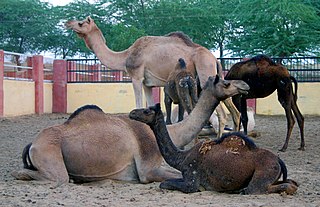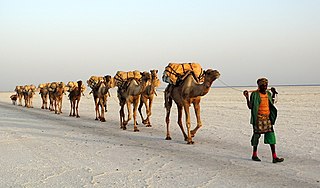 W
WA camel is an even-toed ungulate in the genus Camelus that bears distinctive fatty deposits known as "humps" on its back. Camels have long been domesticated and, as livestock, they provide food and textiles. Camels are working animals especially suited to their desert habitat and are a vital means of transport for passengers and cargo. There are three surviving species of camel. The one-humped dromedary makes up 94% of the world's camel population, and the two-humped Bactrian camel makes up 6%. The Wild Bactrian camel is a separate species and is now critically endangered.
 W
WAustralian feral camels are feral populations of dromedaries in Australia. Imported from British India and Afghanistan during the 19th century for transport and construction during the colonisation of the central and western parts of Australia, many were released into the wild after motorised transport replaced the use of camels in the early 20th century, resulting in a fast-growing feral population.
 W
WThe Bactrian camel, also known as the Mongolian camel or domestic Bactrian camel, is a large even-toed ungulate native to the steppes of Central Asia. It has two humps on its back, in contrast to the single-humped dromedary camel. Its population of two million exists mainly in the domesticated form. Their name comes from the ancient historical region of Bactria.
 W
WCamel racing is a popular sport in Western Asia, North Africa, the Horn of Africa, Pakistan, Mongolia and Australia. Professional camel racing, like horse racing, is an event for betting and tourist attraction. Camels can run at speeds up to 65 km/h in short sprints and they can maintain a speed of 40 km/h for an hour. Camels are often controlled by child jockeys, but allegations of human rights abuses have led to nationwide bans on underage labor in the UAE and Qatar. In modern camel racing, camels are often controlled by remote controlled robotic whips.
 W
WCamel wrestling is a sport in which two male Tülü camels wrestle, typically in response to a female camel in heat being led before them. It is most common in the Aegean region of Turkey, but is also practiced in other parts of the Middle East and South Asia.
 W
WThe Cariboo camels were a number of camels that arrived in British Columbia, Canada, as pack animals. The Bactrian camels were used on the Douglas Road and the Old Cariboo Road in 1862 and 1863 to haul freight during the Cariboo Gold Rush. Although the experiment was a failure, the Cariboo camels retained an almost legendary status in local popular culture.
 W
WThe dromedary, also known as Arabian camel, is a large even-toed ungulate, of the genus Camelus, with one hump on its back.
 W
WA howdah, or houdah, derived from the Arabic هودج (hawdaj), which means "bed carried by a camel", also known as hathi howdah, is a carriage which is positioned on the back of an elephant, or occasionally some other animal such as a camel, used most often in the past to carry wealthy people during progresses or processions, hunting or in warfare. It was also a symbol of wealth for the owner and as a result might be elaborately decorated, even with expensive gemstones.
 W
WA hybrid camel is a hybrid between a Bactrian camel and dromedary.
 W
WInduced ovulation is when a female animal ovulates due to an externally-derived stimulus during, or just prior to, mating, rather than ovulating cyclically or spontaneously. Stimuli causing induced ovulation include the physical act of coitus or mechanical stimulation simulating this, sperm and pheromones.
 W
WMiddle East respiratory syndrome (MERS), also known as camel flu, is a viral respiratory infection caused by Middle East respiratory syndrome–related coronavirus (MERS-CoV). Symptoms may range from none, to mild, to severe. Typical symptoms include fever, cough, diarrhea, and shortness of breath. The disease is typically more severe in those with other health problems.
 W
WNational Research Centre on Camel was established in 1984 by the Central Government under Indian Council of Agricultural Research at the outskirts of Bikaner city to promote research and development on camels. It is located about 8 km from Bikaner city in the state of Rajasthan in India.
 W
WThe Pushkar Fair, also called the Pushkar Camel Fair or locally as Kartik Mela or Pushkar ka Mela is an annual multi-day livestock fair and cultural fête held in the town of Pushkar. The fair starts with the Hindu calendar month of Kartik and ends on the Kartik Purnima, which typically overlaps with late October and early November in the Gregorian calendar. In 1998, over 1 million visitors came to Pushkar throughout the year. The Pushkar fair alone attracts over 200,000 visitors.
 W
WA camel train or caravan is a series of camels carrying passengers and goods on a regular or semi-regular service between points. Although they rarely travelled faster than the walking speed of a person, camels' ability to withstand harsh conditions made them ideal for communication and trade in the desert areas of North Africa and the Arabian Peninsula for centuries. Camel trains were also used sparingly elsewhere around the globe. Since the early 20th century they have been largely replaced by motorized vehicles or air traffic.
 W
WThe wild Bactrian camel is a critically endangered species of camel living in parts of northwestern China and southwestern Mongolia. It is closely related to the Bactrian camel. Both are large, double-humped even-toed ungulates native to the steppes of central Asia. Until recently, wild Bactrian camels were thought to have descended from domesticated Bactrian camels that became feral after being released into the wild. However, genetic studies have established it as a separate species which diverged from the Bactrian camel about 1.1 million years ago.